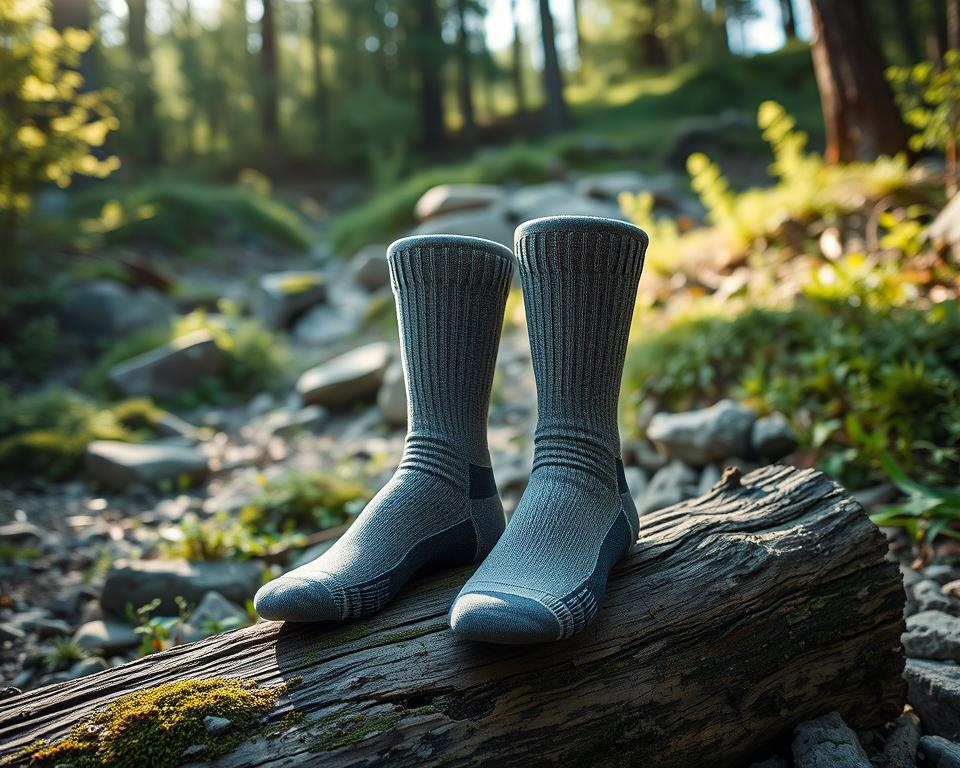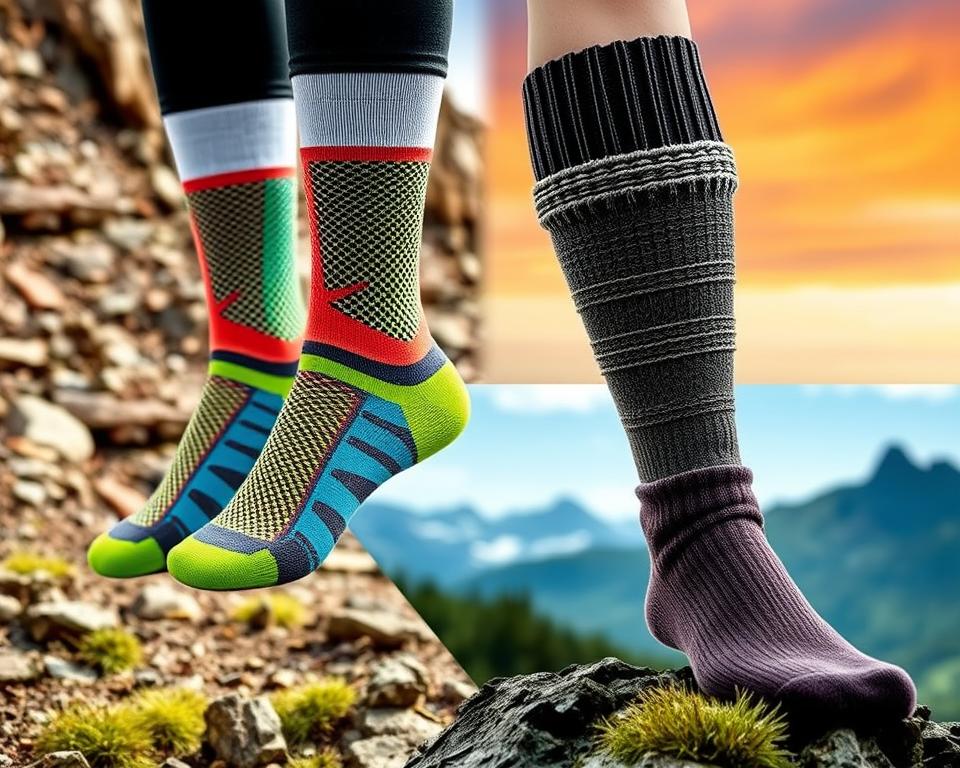Every hiker understands the importance of choosing the right socks for a long hike. There are many options, but the choice often comes down to synthetic versus wool socks. Both materials offer different benefits, like keeping feet dry, controlling odor, or being more affordable. We will dive deeper into these aspects to see which is best for long hikes.
Merino wool is widely praised for its comfort, ability to wick away moisture, and anti-bacterial features. This makes it an excellent choice for extended outdoor activities. Meanwhile, synthetic socks dry much quicker than wool, and they are usually lighter and cost less. Brands such as Darn Tough, Smartwool, and Injinji provide high-quality hiking socks in both materials.
Deciding whether you need wool’s insulation and odor resistance or synthetics’ quick-drying and durability is crucial. Let’s look closely at the characteristics of these sock materials. This will help you make a confident choice.
Introduction to Synthetic and Wool Hiking Socks
Choosing the right hiking socks is important. You must decide between synthetic and wool materials. Each type has benefits for trail comfort and keeping your feet healthy.
What Are Synthetic Hiking Socks?
Synthetic socks are made from materials like polyester and nylon. These fabrics are strong and dry quickly. They work well in warm weather by keeping feet dry and snug.
- Durable and quick-drying
- Suited for warmer weather or transitional seasons
- Enhanced wicking capabilities due to nylon
What Are Wool Hiking Socks?
Wool socks, especially those from Merino wool, offer great features. They regulate temperature naturally, resist odors, and manage moisture. This makes them perfect for all types of weather. They also provide extra cushioning for your feet.
- Outstanding warmth and moisture control
- Natural antimicrobial properties
- Comfortable, durable, and odor-preventing
The Importance of Choosing the Right Hiking Socks
It’s crucial to pick the right socks for hiking comfort and to avoid foot problems. The wrong socks can cause blisters and other issues. Whether you choose synthetic or wool, the best socks meet your hiking needs. They ensure your feet stay comfortable on any adventure.
Comparing Comfort and Fit
When choosing hiking socks, the material is key for comfort and fit. Synthetic and wool materials offer different benefits for hikers. Let’s see how they stack up in temperature control, moisture management, and support.
Temperature Regulation
For cozy hikes, how socks handle temperature is critical. Merino wool socks are great for keeping feet warm or cool as needed. They provide even comfort during your hike.
Synthetic fibers, like polyester, shine in warmer weather. They dry fast and cool down your feet, making them great for summer adventures. They help you maintain a pleasant foot temperature.
Moisture Management
Dealing with sweat is crucial on hikes. Merino wool is great at wicking away moisture, keeping feet dry to avoid blisters. Meanwhile, synthetic socks dry quickly which is handy for sweaty feet.

However, synthetics might not soak up as much sweat as wool. Think about your hike type and weather when choosing sock material for moisture control.
Cushioning and Support
Cushioning and support in socks can enhance hiking. Wool socks offer great padding and support, reducing foot weariness on long treks. Wool’s elasticity equals a snug, comfy fit.
Synthetics might use materials like Lycra for flexibility. Some brands blend wool with synthetic fibers for durability and support. This mix fits well and lasts longer on treks.
In the end, picking between wool and synthetic socks depends on what you need. Both materials have their pros in comfort, temperature control, moisture handling, and support. Knowing these differences helps you choose the best socks for your adventures.
Durability and Longevity of Hiking Socks
Are you team wool or team synthetic for hiking socks? This choice is important for durability on the trail. Whether tackling tough paths or easy walks, your socks must endure. Let’s discuss the lifespan and function of these materials.
Durability of Synthetic vs. Wool
Synthetics, like polyester and nylon, are known for lasting a long time. Polyester is cheap and dries fast. Nylon is very strong. So, synthetic socks are a solid gear choice for hikers. Coolmax socks are great at keeping feet dry by moving moisture away. Plus, spandex makes these socks stretchy and more durable.
Wool socks, especially Merino wool, are impressive too. Merino wool can be bent and twisted up to 20,000 times without breaking. This makes wool socks keep their shape and strength, even after hard use. Smartwool and Darn Tough make durable, comfy hiking socks from this material.
Long-Term Performance
How hiking socks perform over time depends on what they’re made of and how they’re made. Merino wool is super fine and soft, making it comfy for long hikes. It keeps you warm and dry by wicking away sweat.
But, synthetic materials like Thermolite are made for cold activities because they dry fast and keep you warm. Many hikers like a mix of wool and synthetic fibers in their socks. This combo might have 40-70% Merino wool, 20-50% synthetic fibers, and a bit of elastane for stretch.
Hikers say synthetics dry faster, but wool is warmer when wet. So, some carry an extra pair of socks for sleeping. Brands like Smartwool, Pearl Izumi, and Darn Tough make choosing the right socks easier. They offer a good mix of comfort and lasting use.
Want to know more about Merino wool socks? Read Are Merino Wool Hiking Socks Worth the Investment.
Synthetic vs. Wool Hiking Socks for Different Conditions
Planning a hike means knowing the difference between synthetic and wool socks. This choice is crucial as it greatly affects your hiking experience. Let’s explore how each type performs across seasons for the best fit.
Summer Hiking
In summer, synthetic socks are preferred for their lightness and breathability. Brands like Smartwool Run Zero Cushion are sought after for keeping feet cool. Synthetic materials allow for better airflow, reducing sweat on hot days. They dry fast but may not control odors as well as wool does. For more tips, see thisseasonal hiking socks guide.
Winter Hiking
For winter, warmth and insulation are key. Wool socks, especially those made of Merino wool like Smartwool’s, are top choices. They wick moisture and insulate against cold well. Wool keeps you warm and breathes easily, even in freezing conditions. Darn Tough’s extra cushioned socks are also perfect for cold weather comfort and durability.
Wet and Humid Conditions
Synthetic materials excel in wet and humid conditions. They dry faster than wool, making them ideal for rainy hikes. Socks like the Darn Tough Light Hiker Micro Crew dry quickly to prevent blisters. Yet, synthetics might smell over time, a downside to their quick-drying feature.
Both materials offer unique benefits for summer heat, winter cold, or wet trails. By knowing their advantages, you can choose the right socks for any hiking condition.
Which Type of Hiking Sock—Synthetic or Wool—Offers Better Comfort and Durability for Long-Distance Treks?
When embarking on long-distance treks, the choice between synthetic and wool can significantly impact comfort and durability. Wool naturally regulates temperature and wicks moisture, making it ideal for all-day wear. However, synthetic fibers often dry quickly, providing a lightweight option. Ultimately, the best socks for trekking depend on personal preference and climate.
Conclusion
After comparing synthetic and wool hiking socks, it’s clear they both have their benefits and drawbacks. The choice depends on what you prefer for hiking and the conditions you’ll face.
Merino wool socks offer warmth, breathability, moisture-wicking, and antibacterial properties. They make your feet feel comfortable without getting clammy. Their ability to control odor and resist flames makes them great for cold hikes, long trips, or near campfires. Icebreaker is a brand known for quality Merino wool socks, ideal for hiking, walking, and skiing.
Synthetic hiking socks, on the other hand, are lighter, cheaper, and dry faster than wool. They keep you warm without being heavy and last longer, perfect for summer hikes or when you need quick drying. However, they might not feel as comfortable when wet. Brands specializing in synthetic socks focus on affordability and suitability for different conditions.
Making the right choice in hiking socks means looking at your needs and the hike ahead. Whether you choose the comfort of Merino wool or the efficiency of synthetic fibers, the right pair will improve your hike. They ensure your feet stay comfortable and you enjoy your time on the trail.

